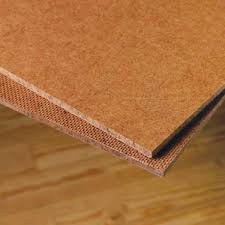
Hardboard (not to be confused with hardwood), also called high-density fiberboard (HDF), is a type of fiberboard, which is an engineered wood product. This product is also known under Isorel or Masonite brand names.
It is similar to particle board and medium-density fiberboard, but is denser and much stronger and harder because it is made out of exploded wood fibers that have been highly compressed. Consequently, the density of hardboard is 31 lbs or more per cubic foot (500 kg/m³) and is usually about 50-65 lbs per cubic foot (800–1040 kg/m³). It differs from particle board in that the bonding of the wood fibers requires no additional materials, although resin is often added. The hardboard variety is made without resin. The HDF version is made with resin. Unlike particle board, it will not split or crack.
Hardboard has long been used in furniture, but it is also popular for use in the construction industry and with trades as a temporary floor protector. Hardboard has become less popular over recent years due to new environmental targets in the construction industry to procure more sustainable temporary protection materials.
Hardboard is produced in either a wet or dry process. The wet process, known as the Mason Method, leaves only one smooth side while the dry processed hardboard is smooth on both sides. Masonite is produced using the wet process only.
Unlike solid wood, hardboard is very homogeneous with no grain. A wood veneer can be glued onto it to give the appearance of solid wood. Other overlays include Formica, laminated papers, ceramics, and vinyl. It has many uses, such as a substrate. It is used in construction, flooring, furniture, home appliances, automobiles and cabinetry, and is popular among acrylic and oil painters as a painting surface due to its economical price (though it must be coated with gesso or canvas before use). Hardboard has often been used as the surface material in clipboards, especially older models. It is also used as the final layer in many skateboard ramps and the half-pipe.
Tempered hardboard is hardboard that has been coated with a thin film of linseed oil and then baked; this gives it more water resistance, impact resistance, hardness, rigidity and tensile strength. An earlier tempering process involved immersing the board in linseed oil or tung oil until it was 5 to 6 percent saturated, and heating to 170 °C (340 °F). Tempered hardboard is used in construction siding.
Perforated hardboard, also called pegboard, is tempered hardboard that has a uniform array of 1/8" or 1/4" holes in it, into which tool-hanging hooks or store fixtures can be placed.
Reuse.
Waste to energy.
Basic Hardboard Products [PDF]
You have no items in your list.
Click or tap on the My List stars on any business card or profile to add or remove organizations.